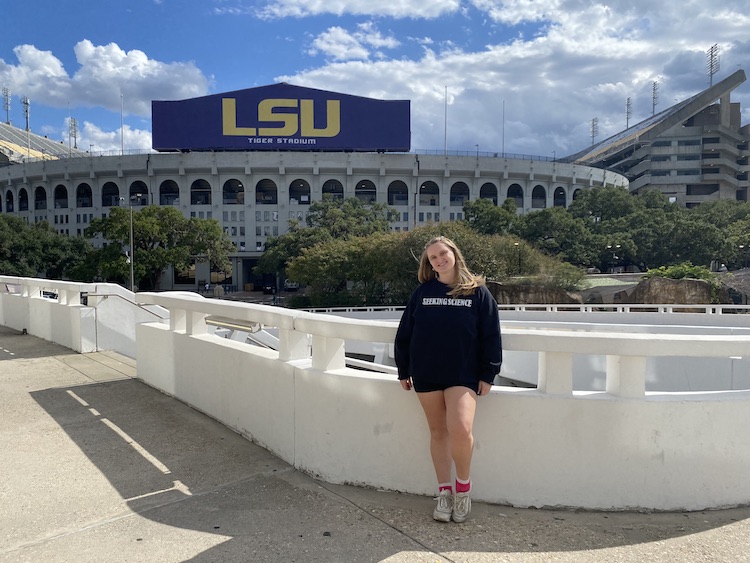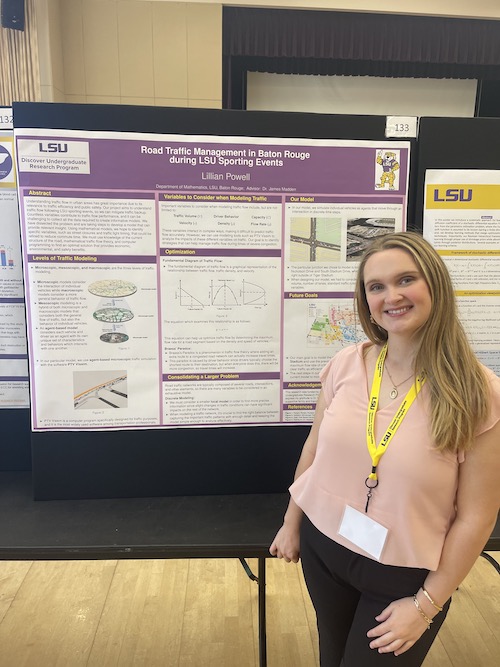Tackling Tiger Traffic: How an LSU Student is Working to Improve Post-Game Traffic

Senior mathematics student Lillian Powell and her mentor Dr. James Madden are working to alleviate traffic after LSU football games.
Photo Credit: Camellia Clifford
Baton Rouge, La. — “Traffic flow is modeled by a theory called chaos,” explained senior mathematical statistics student Lillian Powell, which should come as no surprise to Baton Rouge residents, especially after a home LSU football game.
Chaos theory in mathematics is the study of how seemingly random or unpredictable events and patterns can actually emerge from underlying, deterministic systems. While traffic is inherently unpredictable, a team of Louisiana State University researchers is striving to make the unknown more manageable for LSU football fans.
Under LSU Mathematics professor Dr. James Madden, Powell is aiming to tackle LSU’s post-game traffic problem. She is currently doing research on road traffic management in Baton Rouge during LSU sporting events, specifically football games, and her project is funded by an LSU Discover Project Grant.
The LSU Tigers draw thousands of fans to their football games each year, with Tiger Stadium holding just over 100,000 people, creating major backups when it is time to leave the games.
In 2022, mapping and location technology company TomTom ranked Baton Rouge the 25th-worst city for traffic in the United States. TomTom cites September 10 as the worst day of traffic in Baton Rouge in 2022. On that day, LSU played Southern University, which is also located in Baton Rouge, causing unforgettable traffic for fans from both teams. Slow post-game traffic was exacerbated, and many fans were left sitting in traffic for several hours only to make it a few minutes down the road.
Powell’s own experience sitting in traffic after a game inspired her to explore researching game traffic after LSU games. “I was stuck in traffic, sitting in an Uber for an hour and a half, and through my frustration I realized that, with my previous experience doing research and what I’ve learned in the math curriculum, I could tackle a problem like this,” thought Powell.
Going into the project with a general math background, Powell did not know anything about the math behind traffic. “I just know that [traffic] sucks sometimes…” Powell said with a laugh. “The whole first semester of starting the project was about collecting information that we needed to know.”
Dr. Madden and Powell contacted LSU’s Civil Engineering department for suggestions on effective models, programs, and books for researching traffic flow, as they are currently conducting similar research on hurricane evacuation plans. This information helped Powell begin her research.
In the beginning stages, Powell and Dr. Madden learned things like the levels of traffic modeling - microscopic, mesoscopic and macroscopic - which are used to model traffic flow at different levels of closeness and help determine several factors of traffic, such as interaction between vehicles and behavior of traffic flow, using different equations and methodologies.
The Braze Paradox has been a significant concept in their research. Understanding the theory behind it changed Powell’s perspective on her initial ideas on how to improve traffic.
Powell lives on Ben Hur road, which connects Burbank and Nicholson and is often closed off after games and patrolled by police. She cited her annoyance with its closure, as it negatively impacts her ability to get home after games and, like many others, wondered how it could be possible that street closures benefit the post-game traffic flow.
“But it turns out there's actually this counterintuitive theory in traffic flow called the Braze paradox. And it says that adding an extra route, which would be like opening up Ben Hur road, actually congests the road network more. Because when someone sees that there is a faster route, on Waze, for example, then everyone decides to change course, but it ends up causing more congestion. So one of the things we might look at [while researching] is, testing if they chose the most effective roads to close to make the traffic flow the best,” explained Powell.
Through their research, Powell and Madden were able to determine an equation that models all they have learned about traffic flow. That equation is Flow Rate = Density x Velocity.
“Our goal this semester is to try and use that equation to find a good solution,” said Powell.
LSU uses a contra-flow method after games to move traffic away from Tiger Stadium. However, this method has proven to be contentious, as many fans who live in neighboring communities struggle to get home. An article released September 19, 2023 by Tiger TV reporter Madelyn Frentress stated “The contraflow system forces all traffic to move away from campus. This means that residents who live right off campus may have to drive through the entire route of traffic just to finish less than a mile from where they started.”
The question of contra-flow’s efficiency is one Powell and her team seek to answer. The research team has been in contact with LSU PD, who has provided helpful insight into how the contra-flow method is conducted.

Powell presented her research plans at the last LSU Discover Day and hopes to present her findings and insights from this semester at the next LSU Discover Day in the Spring.
Photo Credit: Lillian Powell
“After talking with LSUPD, I believe it would be interesting to compare the traffic between instances where most people stay until the end versus instances where fans trickle out starting at about halftime. This would be beneficial because the current contraflow system was designed for a ‘max flow rate’, so it is not as effective when there is a traffic trickle effect. So, we are interested in developing a system specifically for the trickling traffic case.” Powell stated.
Powell has faced many roadblocks in the process of her research. Limited budget immediately crossed out the idea of creating new roads, soliciting more police, or creating more traffic stops. Seeking information to aid in research from outside sources has been difficult, as many places are unable to provide the type of data the research team is looking for due to confidentiality and liability issues.
Right now, Powell and her team are using Waze, a navigation smartphone application, to conduct post-game traffic research, as “they provide information such as live traveler’s speed, travel time and the distance of the roadway,” according to Powell. She added that these features on Waze are helpful as they are able to “use those variables to deduce other information such as traffic density which will improve our simulation.”
The researchers focus on “traditionally heavily congested roadways” and begin collecting information about 15 minutes prior to the end of the game. Every 15 minutes for 2 hours after the game, Powell’s research team looks at congestion on Waze, which allows them to then see how congestion changes over time. Powell included that “the traffic will be different for each game since fans typically stay toward the end of the game when the score is close, so we want to collect data from every home game to be able to assess differences in every situation.
“Overall, we want to collect good data that we can then use to program models that compare the two cases of post-game-traffic and max flow rate versus trickle traffic, then we can use that information along with our formula to find optimal traffic light timing specific to each case. We will start with a small microscopic model of one intersection, but we hope to make a model within a one mile radius of Tiger Stadium.” Powell said when speaking about how she plans to go forward with her research.
Eventually, Powell hopes to translate observations from her research into explanations for post-game traffic congestion. From there, her team looks to further collaborate with other departments, like LSU PD and The Athletic Foundation (TAF), and use their research to benefit Baton Rouge traffic for many games to come.
“It's exciting for me to try to figure out something that is so complex. Part of our process has been consolidating that larger problem [of traffic] to be smaller, like tackling one intersection because one small change can affect everything else in a huge network. So taking it piece by piece is a better, more effective method than trying to get it all at once. The process this semester of expanding will probably be full of trials and tribulations. I was really ambitious [deciding to] tackle such a large problem, and I'm far from a solution. But, hopefully, after this semester, we'll have some more answers,” said Powell.
Story by Camellia Clifford, junior in the LSU Manship School of Mass Communication.